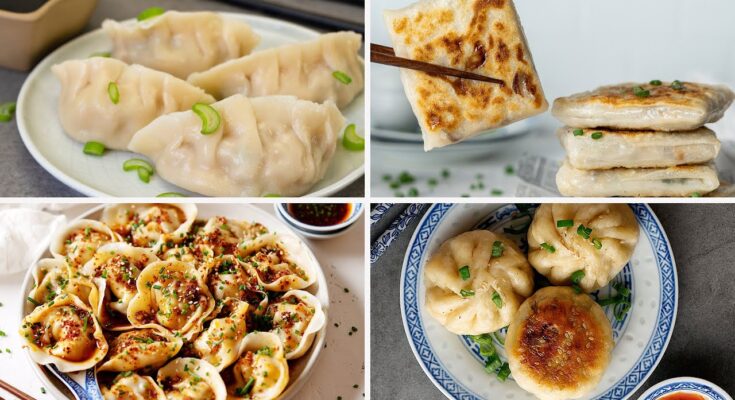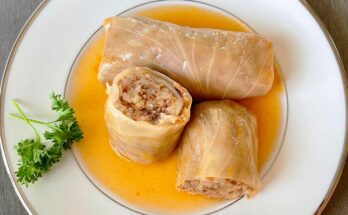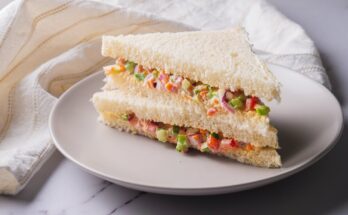Dumpling Recipe: Dumplings are small, bite-sized bundles of joy made from dough, filled with a variety of ingredients like meat, vegetables, or even sweet fillings. They are a versatile dish found in many cuisines, from Chinese jiaozi to Italian ravioli. Dumplings can be steamed, boiled, fried, or baked, offering endless ways to enjoy them. They are comforting, flavorful, and perfect for sharing.
A Brief History of Dumplings
The origin of dumplings dates back thousands of years, with roots in China during the Han Dynasty. They were originally created as a way to stretch ingredients and feed more people. Over time, dumplings spread worldwide, with each region creating unique variations, such as pierogi in Poland, momos in Nepal, and empanadas in Latin America.
Types of Dumplings Around the World
Dumplings come in countless forms. In Asia, you’ll find gyoza in Japan and mandu in Korea. Europe offers gnocchi in Italy and knedliky in the Czech Republic. South American dumplings like empanadas are often baked or fried, and Indian samosas are a crispy, spicy delight. No matter where you are, dumplings offer a taste of cultural tradition and creativity.
Ingredients You’ll Need
For the Dumpling Dough
- 2 cups of all-purpose flour
- ¾ cup of warm water
- A pinch of salt
For the Filling
- 1 cup ground pork, chicken, or tofu (protein of your choice)
- ½ cup finely chopped cabbage
- ¼ cup finely chopped green onions
- 1 tablespoon soy sauce
- 1 teaspoon sesame oil
- 1 teaspoon grated ginger
- 1 clove garlic, minced
Optional Ingredients for Extra Flavor
- A splash of rice vinegar for tanginess
- Chili flakes for a spicy kick
- Fresh herbs like cilantro or parsley for a refreshing touch
Kitchen Tools You’ll Need
Tools for Preparing the Dough
- A large mixing bowl
- A measuring cup
- A rolling pin
Tools for Shaping and Cooking
- A dumpling press (optional but helpful)
- A small spoon for scooping filling
- A steamer basket or skillet for cooking
- A pastry brush (for sealing edges)
How to Make Dumpling Dough
Step 1: Mixing the Ingredients
In a large mixing bowl, combine 2 cups of all-purpose flour with a pinch of salt. Gradually add ¾ cup of warm water while stirring with a wooden spoon or your hands. Mix until the dough starts to come together into a shaggy ball.
Step 2: Kneading the Dough
Transfer the dough to a clean, floured surface. Knead it for about 8-10 minutes until it becomes smooth and elastic. If the dough feels too sticky, sprinkle a little more flour as needed. Proper kneading is key to creating a dough that’s easy to roll and shape.
Step 3: Resting the Dough
Wrap the dough in plastic wrap or place it in a bowl covered with a damp towel. Let it rest for at least 30 minutes. This allows the gluten to relax, making it easier to roll out later.
How to Prepare Dumpling Filling
Step 1: Choosing Your Protein or Vegetables
Decide on the main ingredient for your filling. Ground pork, chicken, tofu, or finely chopped vegetables like mushrooms and carrots work well. Aim for a balance of textures and flavors.
Step 2: Mixing and Seasoning
In a mixing bowl, combine your protein or vegetables with finely chopped cabbage, green onions, soy sauce, sesame oil, grated ginger, and minced garlic. Mix thoroughly until the ingredients are evenly distributed. For a cohesive filling, ensure the mixture isn’t too wet or dry.
Shaping and Assembling Dumplings
Step 1: Rolling Out the Dough
Divide the rested dough into small, equal portions (about the size of a walnut). Roll each portion into a thin circle, approximately 3 inches in diameter. Keep unused dough covered to prevent it from drying out.
Step 2: Adding the Filling
Place a small spoonful of filling in the center of each dough circle. Be careful not to overfill, as this can make sealing difficult.
Step 3: Sealing the Dumplings
Fold the dough over the filling to create a half-moon shape. Pinch the edges firmly to seal, or use a fork for a decorative crimp. For pleated dumplings, fold the edges into small pleats for an elegant finish.
Cooking Dumplings
Steaming Dumplings
Place dumplings in a steamer lined with parchment paper or cabbage leaves to prevent sticking. Steam over boiling water for about 10 minutes or until the filling is fully cooked.
Boiling Dumplings
Bring a pot of water to a rolling boil. Add dumplings in batches, stirring gently to prevent sticking. Cook for 4-6 minutes or until they float to the surface.
Pan-Frying Dumplings
Heat a skillet with a tablespoon of oil. Arrange dumplings in the skillet and cook until the bottoms are golden brown. Add a splash of water, cover, and let them steam for 5 minutes.
Serving Dumplings
Step 1: Choosing a Sauce
A great dipping sauce can elevate your dumplings to a whole new level. Here are some popular options:
- Classic Soy Sauce Mix: Combine soy sauce, rice vinegar, and sesame oil for a tangy, savory dip.
- Spicy Chili Oil: Add a spoonful of chili oil or paste for a spicy kick.
- Sweet and Sour Sauce: Mix honey, vinegar, and a touch of ketchup for a sweet and tangy option.
- Peanut Sauce: For a creamy and nutty flavor, use a peanut-based dipping sauce.
Step 2: Garnishing
Top your dumplings with freshly chopped green onions, sesame seeds, or a drizzle of chili oil for added flavor and presentation. These little touches make your dish look as good as it tastes.
Step 3: Plating
Arrange the dumplings on a serving platter with a small bowl of dipping sauce in the center. Whether you’re hosting guests or enjoying a solo feast, presentation makes the meal feel special.
Tips for Perfect Dumplings
1. Keep the Dough Covered
While working with dough, always keep it covered with a damp towel to prevent it from drying out. Dry dough can crack, making it harder to seal properly.
2. Avoid Overfilling
A common mistake is overloading dumplings with filling. Use just enough to close the dumpling easily, ensuring it doesn’t burst during cooking.
3. Test the Filling
Before assembling all your dumplings, cook a small amount of the filling in a pan to test the seasoning. Adjust salt, soy sauce, or spices as needed.
4. Use Cornstarch for Non-Stick Dumplings
Sprinkle a tray with cornstarch or flour to prevent assembled dumplings from sticking to each other before cooking.
5. Freeze for Later
Dumplings freeze beautifully. Place uncooked dumplings on a tray in the freezer. Once frozen solid, transfer them to an airtight bag. They can go straight from the freezer to boiling water or a hot skillet.
Variations to Try
1. Vegetarian Dumplings
Swap the protein for finely chopped mushrooms, tofu, or a mix of carrots, zucchini, and cabbage. Add a pinch of five-spice powder for depth.
2. Seafood Dumplings
Use shrimp or crab meat as the main protein. Pair it with minced ginger, garlic, and green onions for a delicate, flavorful filling.
3. Sweet Dumplings
For dessert dumplings, fill the dough with sweetened red bean paste, mashed sweet potatoes, or fruit preserves. Steam or fry and sprinkle with powdered sugar.
4. Gluten-Free Dumplings
Use gluten-free flour or rice paper wrappers for a version suitable for dietary restrictions. Be mindful of adjusting water ratios when using alternative flours.
FAQs About Dumpling Recipe
Q: What are dumplings made of?
A: Dumplings are typically made from a combination of flour, water, and sometimes eggs for the dough. The filling can vary widely, including meats, vegetables, or sweet ingredients, depending on the type of dumpling.
Q: Can I make dumpling dough ahead of time?
A: Yes, you can prepare dumpling dough in advance. Wrap it tightly in plastic wrap and refrigerate for up to 24 hours. Let it return to room temperature before rolling and shaping.
Q: What are the common methods to cook dumplings?
A: Dumplings can be steamed, boiled, pan-fried, or deep-fried, depending on the recipe and preference.
Q: Can I freeze dumplings for later use?
A: Absolutely! Arrange uncooked dumplings on a tray, freeze until solid, then transfer them to an airtight container. Cook them directly from frozen without thawing.
Q: How do I prevent dumplings from sticking together?
A: Dust the dumplings lightly with flour or cornstarch before storing or cooking. Ensure they are not touching if freezing.
Q: What sauces go best with dumplings?
A: Dumplings pair well with soy sauce, chili oil, vinegar-based dipping sauces, or even sweet chili sauce, depending on the flavor profile.
Conclusion
Making dumplings at home is a rewarding and delicious experience. From kneading the dough to choosing your fillings and mastering cooking techniques, every step is a chance to infuse love and creativity into your food. Whether you’re preparing them for a family gathering, a cozy dinner, or to stock your freezer, dumplings are a versatile dish that everyone loves. Follow this guide, and soon you’ll be making dumplings like a pro.



